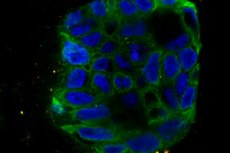New publications
Researchers have discovered a new pathway to cancer cell death with chemotherapy
Last reviewed: 02.07.2025

All iLive content is medically reviewed or fact checked to ensure as much factual accuracy as possible.
We have strict sourcing guidelines and only link to reputable media sites, academic research institutions and, whenever possible, medically peer reviewed studies. Note that the numbers in parentheses ([1], [2], etc.) are clickable links to these studies.
If you feel that any of our content is inaccurate, out-of-date, or otherwise questionable, please select it and press Ctrl + Enter.

Chemotherapy destroys cancer cells. But the way these cells die seems to be different from what was previously understood. Researchers at the Netherlands Cancer Institute, led by Tijn Brummelkamp, have discovered a completely new way cancer cells die: through the gene Schlafen11.
"This is a very unexpected discovery. Cancer patients have been treated with chemotherapy for almost a century, but this pathway to cell death has never been observed before. Where and when this occurs in patients needs to be further investigated. This discovery may ultimately have implications for the treatment of cancer patients." They published their findings in the journal Science.
Many cancer treatments damage the DNA of cells. After too much irreversible damage, cells can initiate their own death. School biology teaches us that a protein called p53 takes control of this process. p53 ensures that damaged DNA is repaired, but initiates cell suicide when the damage becomes too severe. This prevents cells from dividing uncontrollably and forming cancer.
Surprise: Unanswered Question
It sounds like a foolproof system, but the reality is more complicated. "In more than half of tumors, p53 no longer functions," says Brummelkamp. "The main player there, p53, doesn't play any role. So why do cancer cells without p53 still die when you damage their DNA with chemotherapy or radiation? To my surprise, that was an unanswered question."
His research group then discovered, along with colleague Revuena Agami's group, a previously unknown way in which cells die after DNA damage. In the lab, they injected chemotherapy into cells in which they had carefully modified the DNA. Brummelkamp says: "We were looking for a genetic change that would allow the cells to survive chemotherapy. Our group has a lot of experience in selectively disabling genes, which we could fully exploit here."
A new major player in cell death By switching off genes, the research team discovered a new pathway to cell death, led by the gene Schlafen11 (SLFN11). Principal investigator Nicolas Boon said: "When DNA is damaged, SLFN11 switches off the cells' protein factories: the ribosomes. This puts enormous stress on these cells, leading to their death. The new pathway we discovered bypasses p53 entirely."
The SLFN11 gene is not new to cancer research. It is often inactive in tumors from patients who don't respond to chemotherapy, Brummelkamp says. "We can explain this connection now. When cells lack SLFN11, they don't die in this way in response to DNA damage. The cells will survive, and the cancer will continue."
Impact on cancer treatment
"This discovery opens up many new research questions, which is typical in basic research," says Brummelkamp.
"We have demonstrated our discovery in cancer cells grown in the lab, but many important questions remain: Where and when does this pathway occur in patients? How does it affect immunotherapy or chemotherapy? Does it affect the side effects of cancer treatments? If this form of cell death also turns out to be significant in patients, this discovery will have implications for cancer treatment. These are important questions to explore further."
Switching off genes, one at a time Humans have thousands of genes, many of which have functions that are unclear to us. To determine the roles of our genes, researcher Brummelkamp developed a method using haploid cells. These cells contain only one copy of each gene, unlike the normal cells in our bodies, which contain two copies. Handling two copies can be difficult in genetic experiments because changes (mutations) often occur in only one of them. This makes it difficult to observe the effects of these mutations.
Together with other researchers, Brummelkamp has spent years uncovering processes that are critical to disease using this versatile method. For example, his group recently discovered that cells can produce lipids in a different way than previously known.
They have uncovered how certain viruses, including the deadly Ebola virus, manage to enter human cells. They have delved into cancer cells' resistance to certain therapies and identified proteins that act as brakes on the immune system, with implications for cancer immunotherapy.
In recent years, his team has discovered two enzymes that remained unknown for four decades and turned out to be vital for muscle function and brain development.
